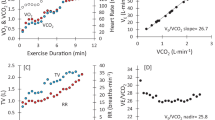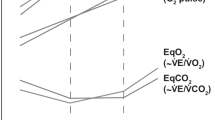Abstract
Patients with cardiovascular diseases commonly present with exercise intolerance, clinically manifest as shortness of breath and fatigue, and these symptoms have important prognostic implications. Cardiopulmonary exercise testing is a well-established method for evaluation of cardiopulmonary diseases. It provides an objective assessment of maximal aerobic capacity (peak VO2), estimates prognosis, and allows the physician to discriminate among many subtle and often overlapping etiologies. This review focuses on the evaluation of important exercise parameters, in addition to the peak VO2, during cardiopulmonary exercise testing.


Similar content being viewed by others
References
Papers of particular interest, published recently, have been highlighted as: •• Of major importance
Mancini DM, Rahko PS, Silver MA, et al.: 2009 Focused Update: ACCF/AHA guidelines for the Diagnosis and Management of Heart Failure in Adults. Circulation 2009; 119:1977–2016
Ansari M, Massie BM: Heart failure: how big is the problem? Who are the patients? What does the future hold? Am Heart J. 2003; 146: 1–4.
American Thoracic Society Statement: Guidelines for cardiopulmonary exercise testing. Am J Respir Care Med 2003; 167: 211–277.
•• Balady GJ, Arena R, Sietsema K, et al.: Clinician’s guide to cardiopulmonary exercise testing in adults. A scientific statement from the American Heart Association. Circulation 2010; 122;191–225. This is a comprehensive review of interpretation of exercise parameters obtained from cardiopulmonary exercise testing as well as its clinical applications.
Arena R, Myers J, Williams MA, et al.: Assessment of functional capacity in clinical and research setting. Circulation 2007; 116:329–343.
Sue DY, Hansen JE: Normal values in adults during exercise training. Clin Chest Med 1984; 5: 89–98.
Mancini DM, Eisen H, Kussmaul W, et al.: Value of peak exercise oxygen consumption for optimal timing of cardiac transplantation in ambulatory patients with heart failure. Circulation 1991;83:778–786.
Lund LH, Aaronson KD, Mancini DM: Validation of peak exercise oxygen consumption and the Heart Failure Survival Score for serial risk stratification in advanced heart failure. Am J Cardiol 2005;95:734–41.
Gibbons RJ, Balady GJ, Bricker JT, et al.: ACC/AHA 2002 Guideline Update for Exercise Testing: Summary Article. Circulation. 2002;106:1883
Swedberg K, Cleland J, Dargie H, et al.: Guidelines for the diagnosis and treatment of chronic heart failure: executive summary (update 2005): The Task Force for the Diagnosis and Treatment of Chronic Heart Failure of the European Society of Cardiology. Eur Heart J 2005;26:1115–40.
Mehra MR, Kobashigawa J, Starling R, et al.: Listing criteria for heart transplantation: International Society for Heart and Lung Transplantation guidelines for the care of cardiac transplant candidates—2006. J Heart Lung Transplant 2006;25:1024–42.
Lund LH, Aaronson KD, Mancini DM: Predicting survival in ambulatory patients with severe heart failure on beta-blocker therapy. Am J Cardiol 2003;92:1350–4.
Milani RV, Lavie CJ, Mehra MR: Cardiopulmonary exercise testing. How do we differentiate the cause of dyspnea? Circulation. 2004;110:e27–e31
Weber KT, Janicki JS, Likoff MJ: Exercise testing in the evaluation of cardiopulmonary disease. A cardiologist’s point of view. Clin Chest Med. 1984;5:173–80.
Mezzani A, Corra U, Bosimini E, et al.: Contribution of peak respiratory exchange ratio to peak VO2 prognostic reliability in patients with chronic heart failure and severely reduced exercise capacity. Am Heart J 2003;145:1102–7.
Brawner CA, Ehrman JK, Aldred H, et al.: Quality assurance and cardiopulmonary exercise testing in clinical trials. J Cardiac Fail 2008; 14: 283–289.
Arena R, Myers J, Williams MA, et al.: AHA scientific statement: assessment of functional capacity in clinical and research settings. Circulation 2007; 116: 329–343.
Sun XG, Hansen JE, Garatachea N, et al.: Ventilatory efficiency during exercise in healthy subjects. Am J Respir Crit Care Med. 2002;166:1443–1448.
Robbins M, Francis G, Pashkow FJ, et al.: Ventilatory and heart rate responses to exercise: better predictors of heart failure mortality than peak oxygen consumption. Circulation 1999; 100:2411–2417.
Arena R, Myers J, Abella J, et al.: Development of a ventilatory classification system in patients with heart failure. Circulation. 2007;155:2410–2417.
Arena R, Myers J, Hsu L, et al.: The minute ventilation/carbon dioxide production slope is prognostically superior to the oxygen uptake efficiency slope. J Card Fail. 2007; 13:462–469.
Arena R, Myers J, Guazzi M: The clinical and research applications of aerobic capacity and ventilatory efficiency in heart failure: an evidence-based review. Heart Fail Rev 2008;13:245–69.
Kleber F, Vietzke G, Wernecke K, et al.: Impairment of ventilatory efficiency in heart failure: prognostic impact. Circulation 2000; 103: 967–972.
Gitt A, Wasserman K, Kilkowski C, et al.: Exercise anaerobic threshold and ventilatory efficiency identify heart failure patients for high risk of early death. Circulation. 2002; 106: 3079–3084.
Tsurungaya H, Adachi H, Kurabayashi M, et al.: Prognostic impact of ventilatory efficacy in heart disease patients with preserved exercise tolerance. Circ J 2006; 70: 1332–1336.
Guazzi M, Myers J, Abella J, et al.: The added prognostic value of ventilatory efficiency to the Weber classification system in patients with heart failure. Int J Cardiol. 2008;129:86–92.
Mancini D, LeJemtel TH: Is ventilatory classification preferable to peak oxygen comsumption for risk stratification in heart failure? Circulation 2007; 115: 2376–2378.
Nanas SN, Nanas JN, Sakellariou DC, et al.: Ve/VO2 slope is associated with abnormal resting hemodynamics and is a predictor of long-term survival in chronic heart failure. Eur J Heart Fail. 2006; 8: 420–427.
Lewis GD, Shah RV, Pappagianopolas PP, et al.: Determinants of ventilatory efficiency in heart failure: the role of right ventricular performance and pulmonary vascular tone. Circ Heart Fail, 2008; 1: 227–233.
Akkerman M, van Brussel M, Hulzebos E, et al.: The oxygen uptake efficiency slope: what do we know? J Cardiopulm Rehabil Prev. 2010. In print.
Albouaini K, Egred M, Alahmar A, et al.: Cardiopulmonary exercise testing and its application. Heart 2007; 93: 1285–1292.
Palange P, Ward SA, Carlsen KH, et al.: ERS Task Force: Recommendations on the use of exercise testing in clinical practice. Eur Respir J 2007; 29: 185–209.
Miles DS, Critz JB, Knowlton RG: Cardiovascular, metabolic and ventilatory responses of women to equivalent cycle ergometer and treadmill exercise. Med Sci Sports Exerc 1980; 12: 14–19.
Wasserman K, Hansen JE, Sue DY, et al.: Normal values. Principles of exercise testing and interpretation. 4th edition. Lippincott Williams & Wilkins (publisher); 2005.
Cicoira M, Davos CH, Francis DP, et al.: Prediction of mortality in chronic heart failure from peak oxygen consumption adjusted for either body weight or lean tissue. J Card Fail 2004; 10: 421–426.
Disclosure
No potential conflicts of interest relevant to this article were reported.
Author information
Authors and Affiliations
Corresponding author
Rights and permissions
About this article
Cite this article
Franco, V. Cardiopulmonary Exercise Test in Chronic Heart Failure: Beyond Peak Oxygen Consumption. Curr Heart Fail Rep 8, 45–50 (2011). https://doi.org/10.1007/s11897-010-0042-4
Published:
Issue Date:
DOI: https://doi.org/10.1007/s11897-010-0042-4




